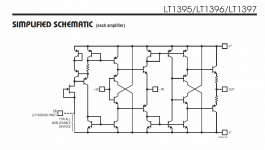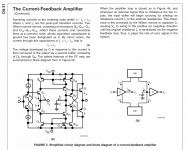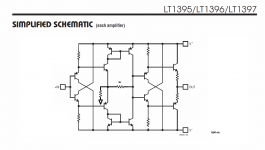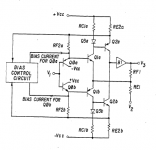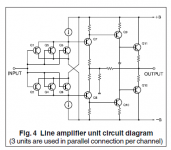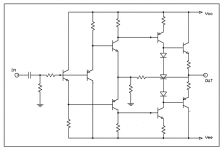That's a nice variation on what has become what might be called the better topologies in use today .... current-mode, too.
TPA6120A2 from TI is current mode as well. It's in a "DWP" package which means that its approx 500x500 mils! Of course, being CFB it requires a pair of opamp buffers.
I couldnt help myself --
I thought that would be a problem -- dc drift/offset --and a challenge. Let me add this, now ---> some circuits which depend on servo to compensate for poor offset/drift will unbalance the amp's distortion null and the distortion will go up... So, yes, you need to start with as stable as possible design without servo... servo should only be used for very fine tuning. Some servo have got a bad rap for making sound bad.... maybe this is why. But, you can do without the servo if careful. ..... watch it over longer time and look over a wide range of expected temp range (not MIL range).
I am now in the middle of nowhere using satellite ($$$) but I couldnt help myself. Thx for the interesting feedback --RNM
--
Output drift is less than about |5| mV over 2 hours or so @ about 100 mA Iq (fairly stable, and this was somewhat the real challenge with such a low Zout design goal), en plein air and with a far-from-optimum layout: not a precision DC amplifier at all, but seems fine for audio - actually a DC servo coluld be not necessary at all, although I've already tested one, just to be on the safe side.
Agree - that's why I'm so curious about your amplifier.
L.
I thought that would be a problem -- dc drift/offset --and a challenge. Let me add this, now ---> some circuits which depend on servo to compensate for poor offset/drift will unbalance the amp's distortion null and the distortion will go up... So, yes, you need to start with as stable as possible design without servo... servo should only be used for very fine tuning. Some servo have got a bad rap for making sound bad.... maybe this is why. But, you can do without the servo if careful. ..... watch it over longer time and look over a wide range of expected temp range (not MIL range).
I am now in the middle of nowhere using satellite ($$$) but I couldnt help myself. Thx for the interesting feedback --RNM
--
I've read the article at last. A bit short, and leave me wonder what to do to raise the current. Very smart the input stage instead, that tickles me enough to want to try the amp, but probably with different output devices.
PS: thd20 has been measured? The only reference to closed loop performance is <.001% thd which doesn't tell much.
PS: thd20 has been measured? The only reference to closed loop performance is <.001% thd which doesn't tell much.
maybe i should make up some kits of matched input and output devices.
yes please
I've just finished reading this entire thread, all 245 posts.
It was exceedingly onerous.
Discussing a circuit without having the schematic is like, oh, screw it, make up your own analogy. I'll probably grab a copy of Linear Audio. As Jan said, these kinds of publications are thin on the ground now, and will probably disappear completely in the not too distant future. That's not really the point. The point is there is a ~250 post thread about a headphone amplifier with only the buffer version presented. It's needlessly frustrating to wade through.
Could we get a "public domain" version of the full amplifier schematic posted here, please? It doesn't have to be annotated, it can have the part values redacted, you can even "black box" bits if you need to ...
It was exceedingly onerous.
Discussing a circuit without having the schematic is like, oh, screw it, make up your own analogy. I'll probably grab a copy of Linear Audio. As Jan said, these kinds of publications are thin on the ground now, and will probably disappear completely in the not too distant future. That's not really the point. The point is there is a ~250 post thread about a headphone amplifier with only the buffer version presented. It's needlessly frustrating to wade through.
Could we get a "public domain" version of the full amplifier schematic posted here, please? It doesn't have to be annotated, it can have the part values redacted, you can even "black box" bits if you need to ...
Coluke, your circuit interests me. It's a variation on a theme I catch a glimpse of from time to time, but I've never tracked it down to any comprehensive source. Can you give me a little bit of background on it?
I've just finished reading this entire thread, all 245 posts.
It was exceedingly onerous.
tsk tsk, amateur
Try reading the blowtorch thread
Could we get a "public domain" version of the full amplifier schematic posted here, please? It doesn't have to be annotated, it can have the part values redacted, you can even "black box" bits if you need to ...[/QUOTE]
I have my paper copy, but I agree with this request; it wouldn't do any harn to LA imo.
It's a variation on a theme I catch a glimpse of from time to time, but I've never tracked it down to any comprehensive source. Can you give me a little bit of background on it?
Hi rjm - if a comprehensive source of information about CF architectures exists at all, I haven't found it yet
L.
Last edited:
@coluke
Thanks for the numerous resources! It's interesting (and impressive) that you worked from "scratch", that is, developed your amplifier circuit from non-audio specific references. I had hoped that there might be line of experience for dealing with these circuits in audio applications, where stability under non-ideal loads, rather than ultra-high bandwidth weighs more heavily on the designer's mind...
(all I found so far was this.)
Thanks for the numerous resources! It's interesting (and impressive) that you worked from "scratch", that is, developed your amplifier circuit from non-audio specific references. I had hoped that there might be line of experience for dealing with these circuits in audio applications, where stability under non-ideal loads, rather than ultra-high bandwidth weighs more heavily on the designer's mind...
(all I found so far was this.)
Attachments
Last edited:
My starting point were the Sergio Franco's chapter on CF Amplifiers in Analog Circuit Design -
I love Sergio Franco's works I am so indebted...
Thanks for the reminder
-Antonio
The patent on the CFB amp was in 1982 by Comlinear Corp (...)
You're right - the original one by Nelson & Saller should be US patent 4502020.
L.
Attachments
@rjm - as far as I know only Accuphase and Marantz are employing (or have employed) CF topologies in their commercial products, but mainly in preamplifiers. Accuphase's architecture (see the first attachment) is pretty standard (a few old CF opamp by National are based on it), simple and straightforward, and I have indeed verified it works very well using it in a small power wide-BW class AB output buffer for testing purpose (it is capable of almost 20 Vpp into 50 ohm up to 1 MHz with low THD), but if open-loop linearity and gain are of paramount importance then current mirrors in the transimpedance stage are needed - open loop performances of the DB-CM-DB architecture are quite amazing 
L.
L.
Attachments
@rjm - as far as I know only Accuphase and Marantz are employing (or have employed) CF topologies in their commercial products, but mainly in preamplifiers.
L.
Since 1990 Accuphase only employ current feedback topologies in their preamps and amps, Marantz is a late comer to the topology. Pioneer, Harmon kardon Sony, Cyrus, Yamaha and a host of others have used the topology, some since since middle 1980s. The most famous and well known was pioneer A400x amp which was applauded for its good sound and cheap price in early 1990s. Also from pioneer youll find the most refined and innovative use of CFB in non feedback and feedback type amps dating from late 80s.
RJM if youre looking for info on CFB National semiconductors (now Texas instruments) papers OA18, OA13 and OA15 is a must have. You need to google for a paper called SmithCFB.pdf too. With these youll know everything there is to know about CFB, the basics that is. The design can then be further refined using wideband techniques and feedforward to improve bandwith slewrate, THD and settling. These refinements are up to you to make though. Start with diamond output buffer seen in your posts.
@RNMarsh
Several posts back, you mention still finding the specified jfets at a decent price on the net. But all I could locate were Chinese suppliers offering at that price. So it makes me wonder if the jfets are the real deal on ebay. I am hoping to stick to the parts you specified in the article.
Several posts back, you mention still finding the specified jfets at a decent price on the net. But all I could locate were Chinese suppliers offering at that price. So it makes me wonder if the jfets are the real deal on ebay. I am hoping to stick to the parts you specified in the article.
Last edited:
dont know if sources are 'real'
I just looked up jFET's on Internet and bought the lowest priced ones. They were from China and they worked fine. And delivery to my home was very fast. -RNM
@RNMarsh
Several posts back, you mention still finding the specified jfets at a decent price on the net. But all I could locate were Chinese suppliers offering at that price. So it makes me wonder if the jfets are the real deal on ebay. I am hoping to stick to the parts you specified in the article.
I just looked up jFET's on Internet and bought the lowest priced ones. They were from China and they worked fine. And delivery to my home was very fast. -RNM
- Home
- Amplifiers
- Headphone Systems
- Marsh headphone amp from Linear Audio
